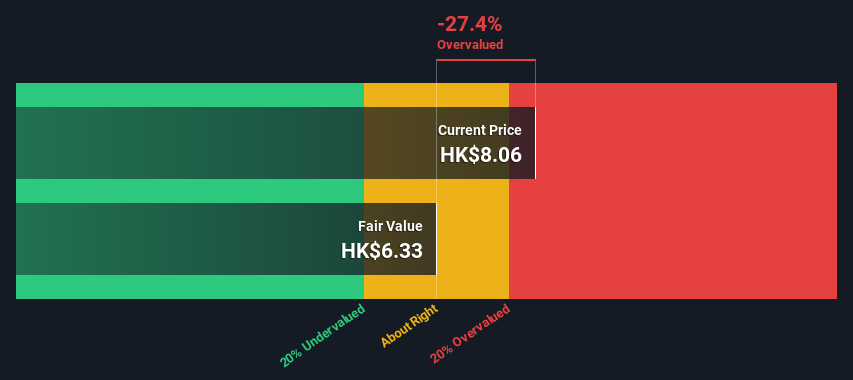- Hong Kong
- /
- Oil and Gas
- /
- SEHK:1138
Is COSCO SHIPPING Energy Transportation Co., Ltd. (HKG:1138) Worth HK$8.1 Based On Its Intrinsic Value?

Key Insights
- COSCO SHIPPING Energy Transportation's estimated fair value is HK$6.33 based on 2 Stage Free Cash Flow to Equity
- Current share price of HK$8.06 suggests COSCO SHIPPING Energy Transportation is potentially 27% overvalued
- The CN¥10.57 analyst price target for 1138 is 67% more than our estimate of fair value
Today we will run through one way of estimating the intrinsic value of COSCO SHIPPING Energy Transportation Co., Ltd. (HKG:1138) by estimating the company's future cash flows and discounting them to their present value. One way to achieve this is by employing the Discounted Cash Flow (DCF) model. Models like these may appear beyond the comprehension of a lay person, but they're fairly easy to follow.
We generally believe that a company's value is the present value of all of the cash it will generate in the future. However, a DCF is just one valuation metric among many, and it is not without flaws. Anyone interested in learning a bit more about intrinsic value should have a read of the Simply Wall St analysis model.
View our latest analysis for COSCO SHIPPING Energy Transportation
Step By Step Through The Calculation
We're using the 2-stage growth model, which simply means we take in account two stages of company's growth. In the initial period the company may have a higher growth rate and the second stage is usually assumed to have a stable growth rate. In the first stage we need to estimate the cash flows to the business over the next ten years. Seeing as no analyst estimates of free cash flow are available to us, we have extrapolate the previous free cash flow (FCF) from the company's last reported value. We assume companies with shrinking free cash flow will slow their rate of shrinkage, and that companies with growing free cash flow will see their growth rate slow, over this period. We do this to reflect that growth tends to slow more in the early years than it does in later years.
Generally we assume that a dollar today is more valuable than a dollar in the future, and so the sum of these future cash flows is then discounted to today's value:
10-year free cash flow (FCF) estimate
| 2024 | 2025 | 2026 | 2027 | 2028 | 2029 | 2030 | 2031 | 2032 | 2033 | |
| Levered FCF (CN¥, Millions) | CN¥2.29b | CN¥2.40b | CN¥2.50b | CN¥2.58b | CN¥2.66b | CN¥2.73b | CN¥2.79b | CN¥2.85b | CN¥2.91b | CN¥2.97b |
| Growth Rate Estimate Source | Est @ 6.25% | Est @ 4.94% | Est @ 4.02% | Est @ 3.38% | Est @ 2.93% | Est @ 2.61% | Est @ 2.39% | Est @ 2.24% | Est @ 2.13% | Est @ 2.06% |
| Present Value (CN¥, Millions) Discounted @ 11% | CN¥2.1k | CN¥2.0k | CN¥1.8k | CN¥1.7k | CN¥1.6k | CN¥1.5k | CN¥1.4k | CN¥1.3k | CN¥1.2k | CN¥1.1k |
("Est" = FCF growth rate estimated by Simply Wall St)
Present Value of 10-year Cash Flow (PVCF) = CN¥16b
We now need to calculate the Terminal Value, which accounts for all the future cash flows after this ten year period. For a number of reasons a very conservative growth rate is used that cannot exceed that of a country's GDP growth. In this case we have used the 5-year average of the 10-year government bond yield (1.9%) to estimate future growth. In the same way as with the 10-year 'growth' period, we discount future cash flows to today's value, using a cost of equity of 11%.
Terminal Value (TV)= FCF2033 × (1 + g) ÷ (r – g) = CN¥3.0b× (1 + 1.9%) ÷ (11%– 1.9%) = CN¥35b
Present Value of Terminal Value (PVTV)= TV / (1 + r)10= CN¥35b÷ ( 1 + 11%)10= CN¥13b
The total value, or equity value, is then the sum of the present value of the future cash flows, which in this case is CN¥28b. In the final step we divide the equity value by the number of shares outstanding. Relative to the current share price of HK$8.1, the company appears slightly overvalued at the time of writing. The assumptions in any calculation have a big impact on the valuation, so it is better to view this as a rough estimate, not precise down to the last cent.

The Assumptions
Now the most important inputs to a discounted cash flow are the discount rate, and of course, the actual cash flows. If you don't agree with these result, have a go at the calculation yourself and play with the assumptions. The DCF also does not consider the possible cyclicality of an industry, or a company's future capital requirements, so it does not give a full picture of a company's potential performance. Given that we are looking at COSCO SHIPPING Energy Transportation as potential shareholders, the cost of equity is used as the discount rate, rather than the cost of capital (or weighted average cost of capital, WACC) which accounts for debt. In this calculation we've used 11%, which is based on a levered beta of 1.444. Beta is a measure of a stock's volatility, compared to the market as a whole. We get our beta from the industry average beta of globally comparable companies, with an imposed limit between 0.8 and 2.0, which is a reasonable range for a stable business.
SWOT Analysis for COSCO SHIPPING Energy Transportation
- Debt is well covered by earnings and cashflows.
- Dividends are covered by earnings and cash flows.
- Dividend is low compared to the top 25% of dividend payers in the Oil and Gas market.
- Expensive based on P/E ratio and estimated fair value.
- Annual revenue is forecast to grow faster than the Hong Kong market.
- Annual earnings are forecast to grow slower than the Hong Kong market.
Moving On:
Whilst important, the DCF calculation is only one of many factors that you need to assess for a company. The DCF model is not a perfect stock valuation tool. Preferably you'd apply different cases and assumptions and see how they would impact the company's valuation. For example, changes in the company's cost of equity or the risk free rate can significantly impact the valuation. Can we work out why the company is trading at a premium to intrinsic value? For COSCO SHIPPING Energy Transportation, we've compiled three further factors you should assess:
- Risks: Consider for instance, the ever-present spectre of investment risk. We've identified 1 warning sign with COSCO SHIPPING Energy Transportation , and understanding it should be part of your investment process.
- Future Earnings: How does 1138's growth rate compare to its peers and the wider market? Dig deeper into the analyst consensus number for the upcoming years by interacting with our free analyst growth expectation chart.
- Other High Quality Alternatives: Do you like a good all-rounder? Explore our interactive list of high quality stocks to get an idea of what else is out there you may be missing!
PS. Simply Wall St updates its DCF calculation for every Hong Kong stock every day, so if you want to find the intrinsic value of any other stock just search here.
New: AI Stock Screener & Alerts
Our new AI Stock Screener scans the market every day to uncover opportunities.
• Dividend Powerhouses (3%+ Yield)
• Undervalued Small Caps with Insider Buying
• High growth Tech and AI Companies
Or build your own from over 50 metrics.
Have feedback on this article? Concerned about the content? Get in touch with us directly. Alternatively, email editorial-team (at) simplywallst.com.
This article by Simply Wall St is general in nature. We provide commentary based on historical data and analyst forecasts only using an unbiased methodology and our articles are not intended to be financial advice. It does not constitute a recommendation to buy or sell any stock, and does not take account of your objectives, or your financial situation. We aim to bring you long-term focused analysis driven by fundamental data. Note that our analysis may not factor in the latest price-sensitive company announcements or qualitative material. Simply Wall St has no position in any stocks mentioned.
About SEHK:1138
COSCO SHIPPING Energy Transportation
An investment holding company, engages in the shipment of oil, liquefied natural gas (LNG), and chemicals along the coast of the People’s Republic of China and internationally.
Undervalued with adequate balance sheet.

